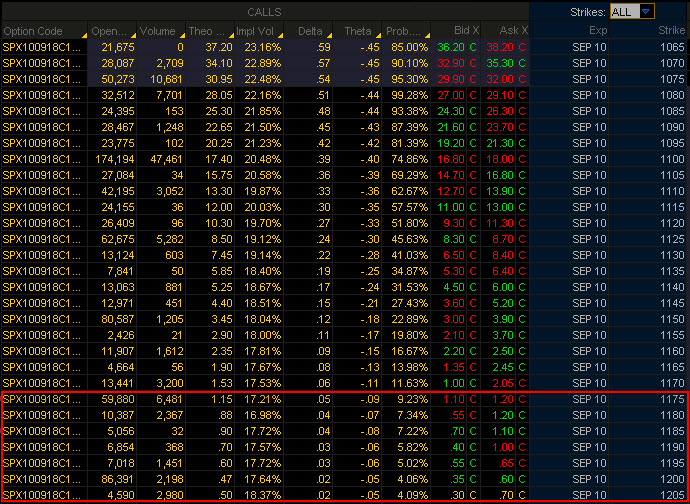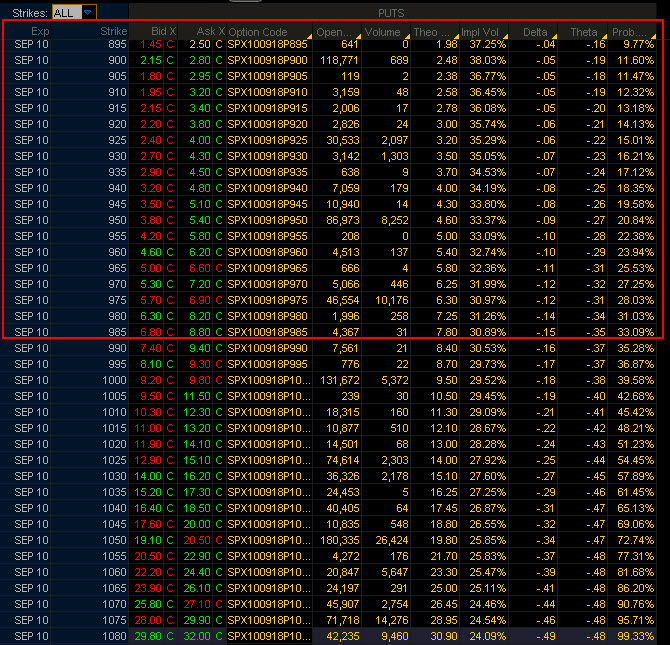So far I’ve outlined some historical ranges and gone through some technical analysis on the $SPX in an attempt to show how I approach the market. In this post I delve into the option chains to see what’s being offered and where I can sell premium that aligns with my analysis.
A few rules that I follow when deciding where to sell:
- I don’t want to own more than 10% of the open interest
- I’d like to take in a .50 or better credit for the spread
- I NEVER sell naked but always use protection in the form of a further out-of-the-money option…ALWAYS
In the image below I can see that the calls offer very little in the way of premium for out-of-the-money strikes. This is in line with the overall near-term trend of lower highs/lower lows seen in my technical analysis. I know through the historical analysis of range that I can write any of the calls in the red box and the odds (acceptable by me) are in my favor that they will expire worthless. This doesn’t mean I just jump in and start selling at the first strike but rather start looking there.
 I can see from the put chain below that there is far more interest in the downside when looking at the premium being paid for out-of-the-money strikes. My analysis suggests that I can write any of the strikes that are outlined in the red box. However, I also look at the probability of touching and the probability of expiring worthless. I like the probability of touching to be under 20% and really prefer to sell around that level. The 950 put has a 20.84% probability of being touched during the September cycle and that is a good starting point.
I can see from the put chain below that there is far more interest in the downside when looking at the premium being paid for out-of-the-money strikes. My analysis suggests that I can write any of the strikes that are outlined in the red box. However, I also look at the probability of touching and the probability of expiring worthless. I like the probability of touching to be under 20% and really prefer to sell around that level. The 950 put has a 20.84% probability of being touched during the September cycle and that is a good starting point.
 My approach focuses on time decay (Theta erosion) and not so much on volatility or other greeks. However, that doesn’t mean I don’t look at them. I’ll pull up the historical/implied volatility chart and see what it suggests. In the chart below I can see that the 30-day HV has been on a steady decline since the June expiry. I also notice that the IV has recently seen a nice pop since crossing over HV. As a premium seller I like to see the elevated level of implied volatility as it means traders are willing to pay more premium for their options. Elevated levels of implied volatility are nice, but it also suggests that there is some pending event (real or imagined) that is more than likely causing the rise. Therefore, I need to have a handle on macro and geopolitical issues that can impact the market.
My approach focuses on time decay (Theta erosion) and not so much on volatility or other greeks. However, that doesn’t mean I don’t look at them. I’ll pull up the historical/implied volatility chart and see what it suggests. In the chart below I can see that the 30-day HV has been on a steady decline since the June expiry. I also notice that the IV has recently seen a nice pop since crossing over HV. As a premium seller I like to see the elevated level of implied volatility as it means traders are willing to pay more premium for their options. Elevated levels of implied volatility are nice, but it also suggests that there is some pending event (real or imagined) that is more than likely causing the rise. Therefore, I need to have a handle on macro and geopolitical issues that can impact the market.
 In all honesty my volatility skills are lacking and I’d be doing a disservice if I didn’t point you to one of my all-time favorite trading books. Many of you know Adam Warner and his book is what I’d consider THE book on volatility. It’s a very easy read and the knowledge I gained about when to sell is worth the cover price alone. As far as my macro skills are considered I’d rate them elementary at best. I don’t proclaim to be an expert about selling premium nor do I tout my macro skills. Instead, I subscribe to newsletters of those that do have a special skill for the areas I lack. My favorite macro newsletter is Dave Taggart’s “The Macro Trader“. He is very thorough in his analysis and has a respectable track record.
In all honesty my volatility skills are lacking and I’d be doing a disservice if I didn’t point you to one of my all-time favorite trading books. Many of you know Adam Warner and his book is what I’d consider THE book on volatility. It’s a very easy read and the knowledge I gained about when to sell is worth the cover price alone. As far as my macro skills are considered I’d rate them elementary at best. I don’t proclaim to be an expert about selling premium nor do I tout my macro skills. Instead, I subscribe to newsletters of those that do have a special skill for the areas I lack. My favorite macro newsletter is Dave Taggart’s “The Macro Trader“. He is very thorough in his analysis and has a respectable track record.
At this point I’d put a few feeler orders out for spreads that meet my criteria outlined above. I may sit and watch certain spreads during the day to see what the volume looks like or maybe an individual strike in order to leg into a spread. For the most part I focus on the $ 10 spread as that allows me to define my risk at a level I’m comfortable with. I’ll talk more about defining risk and managing the position in part 4.

